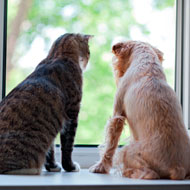Dogs react to cat sounds more than sight or smell - study

"It may be possible to use audio recordings of cats to assess which shelter dogs are likely to fare well in a home with cats or other small animals"
Dogs are more responsive to the sound of cats than they are to their sight or smell, according to new research.
Writing in the journal Applied Animal Behaviour Science, scientists note that dogs with a history of killing or injuring a cat are particularly responsive to cat sounds.
The findings suggest that employing behavioural assessments that engage the senses, particularly hearing, could offer clues about an individual dog's behaviour.
“Indeed, it may be possible to use audio recordings of cats to assess which shelter dogs are likely to fare well in a home with cats or other small animals,” said lead author Dr Christy Hoffman, assistant professor of animal behaviour at Canisius University.
Adoption shelters are often asked ‘what is the dog like with cats’. But according to Hoffman, there is no proven method to predict how a dog will behave around cats - unless the shelter is aware of the dog’s history.
To see what a cat-friendliness assessment might look like, Hoffman and her team analysed the responses of 69 pet dogs, of a variety of breeds, when presented with three different stimuli: a realistic looking cat doll, the smell of cat urine, and recordings of cat sounds.
They found that the dogs were more responsive to cat sounds than they were to visual or olfactory information. In particular, dogs that had killed a cat or other small animal spent longer attuning to cat sounds than the other dogs.
The researchers found no relationship between dogs that had killed cats before and their reactions to the sight and smell of cats.
“As humans, our first thought was to test the dogs’ responses to the cat doll because it visually resembles a real cat,” explained Hoffman. “However, our findings suggest that dogs are relying more heavily on another sense, hearing. This was surprising since most behavioural assessments focus on responses to visual stimuli.”



 The BSAVA has opened submissions for the BSAVA Clinical Research Abstracts 2026.
The BSAVA has opened submissions for the BSAVA Clinical Research Abstracts 2026.